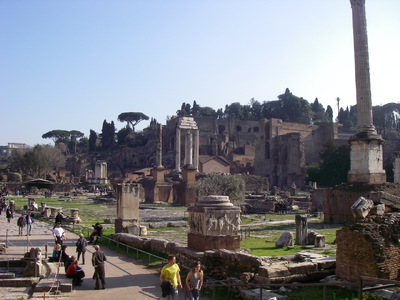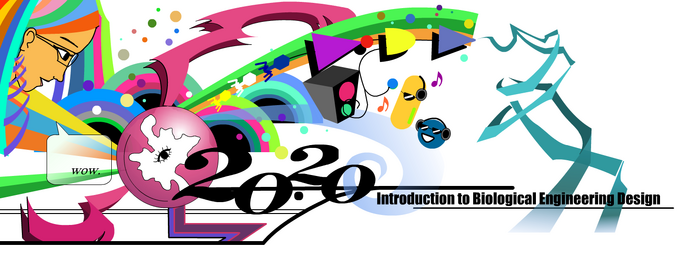2020(S10) Lecture:week 3
Week 3 Studio
Part 1: The Sorting Hat
Based on the ideas from your letters, comic strips and storyboards the class will be organized into TEMPORARY camps. These camps are intended to cluster related projects and will include all the interesting corners and regions of the project areas you've defined so far. Each camp will also be assigned one or more senior biological engineering student(s) from 20.385 as the camp counselor(s). Once sorted, you, your camp-mates and your counselor(s) should review and catalog the ideas that got you there. In cataloging your ideas, you should include
- a name for each project
- a one sentence description of the problem or opportunity it will address
- and any idea you're working on as a solution.
Prepare this catalog as a powerpoint presentation that you will show to the class. The last slide in your presentation should be a recap slide to review all the ideas presented. The last hour of the studio time will be dedicated to the presentation of these camp catalogs.
Part 2: Mapping the world of projects
Pull up a chair and listen as your classmates present their catalogs of ideas. As you listen , you should make note of those projects from each camp that are most interesting to you and why. Before tomorrow you will be asked list your top choice choice for camps and your top three project ideas.
Here are today's presentations:
Homework for tomorrow's challenge session
- First, reconsider the challenges and opportunities that were presented in today's studio.
- Then select your 3 favorite project ideas and top "camp" choice. Before next week, you'll be assigned a team and, as a team, you'll get started on 3 ideas in your area of interest.
- Finally, upload your choices before tomorrow's studio session to your "Personal Design Portfolio" in the homework dropbox, calling your assignment: FirstInitial_LastName_PDP_5.doc, for example: P_Abdul_PDP_5.doc
Week 3 Thursday
Today we'll consider the engineering of artifacts that we hope will behave exactly as designed. Good luck, right! It seems like very little goes from drafting board to perfect in one cycle. More often there are ways we design in the face of uncertainty. For instance consider this "request for proposals" from the defense agency, DARPA:
Pentagon: $6M to breed immortal "synthetic organisms"
Called "the most radical project yet," the pentagon is investing $6 million in a "bio-bot," i.e. a synthetic organism that will live forever...or at least until its kill-switch is thrown by the inventor. Read about the call for proposals and the concerns surrounding this immortal living agent
here.
Even before this project was suggested, a reasonable person might have asked how can we make a plan (much less a living organism) for the next century or millennium when we don't know what the world will be like in the future? Technology advances so quickly. The world is a changing and uncertain place. But nature has built in some remarkable flexibility in to life's designs. Today we'll consider what we can learn for nature's designs in the face of an unknowable future.
Challenge: The Clock of the Long Now
Humans have had a stable climate for about 10,000 years, let's hope for another 10,000 at least. Assuming no catastrophic events, what would you like to build now that could still be working 10,000 years from now? How could you build such a long-lasting artifact? Wisely anticipating future needs is part of it. For example carpenters in the 14th century built marvelous wooden cathedrals. At the same time, the builders knew that the beams of the structures would eventually need replacing. So, they planted trees, preparing hundreds of years ahead by providing for the future raw materials needs. What else might need to be pre-positioned to perpetuate an artifact through time?

Instructions: Work together to design a clock inspired by Danny Hill's specifications. Danny called for "a clock that ticks once a year, the century hand advances once every one hundred years, and the cuckoo comes out on the millennium. I want the cuckoo to come out every millennium for the next 10,000 years." Several design considerations will be important to discuss as you think about how to build a clock that will behave as expected until the year 12,000. NOTE: Your clock must only keep track of time and years. No cuckoo is needed unless you want one. You will have 30 minutes to address these aspects of your clock's design and documentation:
- longevity: how will you keep the clock working, presuming you'll have all and only the technology and materials that are available today?
- maintenance: how will your children's children's children keep this clock working? You can assume they'll be as smart but no smarter than you.
- user's guide: how will future generations understand this clock without stopping or disassembling it?
- improvements: how will you improve your clock over time? It should be possible to improve the clock over time?
- prototyping: how will you build and test your clock?
Here's how we'll begin:
- A quick review of how nature counts.
- A quick review of synthetic oscillators.
- A quick review for the rules of brainstorming (see Part 3 here)
Now:
Build consensus around one idea or take a vote for the top 3 and then the top choice. Once the general idea for your clock is set, get to work on each of the design elements listed above.
After 30 minutes, each table will report back to the group. You may want to organize your ideas or sketch your plan on the whiteboards.
Why are we doing this??
Designing in the absence of complete knowledge is the norm, not the exception. Once our "clocks for the long now" have been described, we'll work as a class to add more ideas, questions and thoughts about good designs despite incomplete understanding. We can also collect the problem solving techniques that worked well and those that didn't.
- from 2008: "I learned from this that technology can provide a wonderful varieties of possibilities, but also that nature has created a pretty elegant machine in living organisms. The best engineering solutions may be those that alter the natural system the least or at least recombine functional pieces of nature."
- from 2008: "This activity was a lot of fun for me, although I must admit, I was intimidated by it at first. When we actually got together to design the clock, ideas were flying everywhere. At first, we all seemed to be thinking the same, which was nice to start off with."
- from 2009: "We started off with a lot of ideas but eventually went for the simplest of all..."
- from 2009: "We decided that redundancy was the only thing that might work"
- from 2010: "We had to assume stable conditions for tree growth and find a way to measure without harming the plant, redundancy seems like a good idea (many trees or many clocks), but how to reconcile outputs if different?"
Homework for next week's studio session
In this assignment you will address the characteristics of "good design." For instance, Joel Schindall from the Gordon Engineering Leadership Program offers these as elements of good product design:
- You know it when you see it
- Minimalist -- meets requirements in an efficient manner
- Wow factor -- leaps out at you
- Robust -- failure-resistant
- "Anticipatory" -- easily modified to overcome unanticipated problems (this is subtle but important)
- Adaptable
- Expandable
- Flexible
- Combines functions to increase efficiency -- mounting bracket doubles as heat sink, etc.
By contrast, Blade Kotelly from Endeca Technologies offers these elements of good software design:
- Visually Clean
- Communicates clearly and quickly
- Anthropomorphic
- Useful in some way (intended or unintended)
- Provides clear feedback
- Keeps users oriented as to their current state
- Maintains locus of control with user
- Emotionally compelling
- Provides simple controls for input
- Aligns to societal mores
Now it's your turn. Please make 2 lists. The first list should be 5-10 characteristics of good design in biology as we find it in the natural world. The second list should be 5-10 characteristics of good design in biologically engineered technologies. Please upload your letter to your "Personal Design Portfolio" in the homework dropbox, calling your assignment: FirstInitial_LastName_PDP_6.doc, for example: S_Jobs_PDP_6.doc
Why are we doing this??
As you start to design your own projects, it's important to think at a high level about "good design" elements. If you can articulate "what makes it great," then you should be in a powerful position to make wise decisions about project ideas, to accurately evaluate competing ideas and technologies, and to fully appreciate of what exists and what can be improved.
